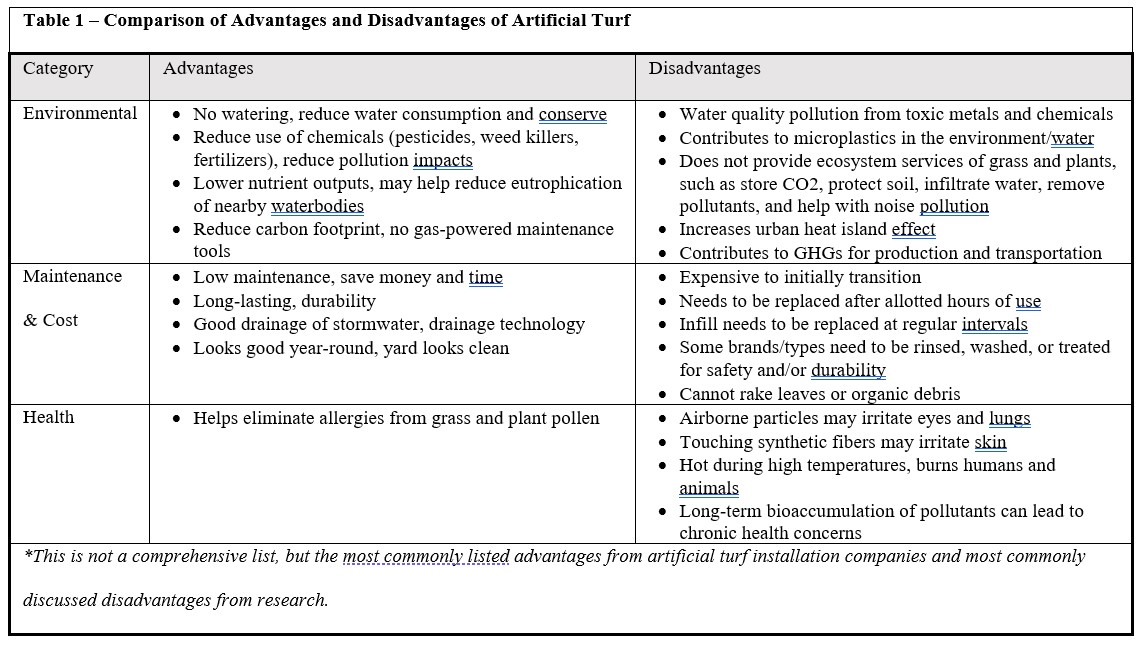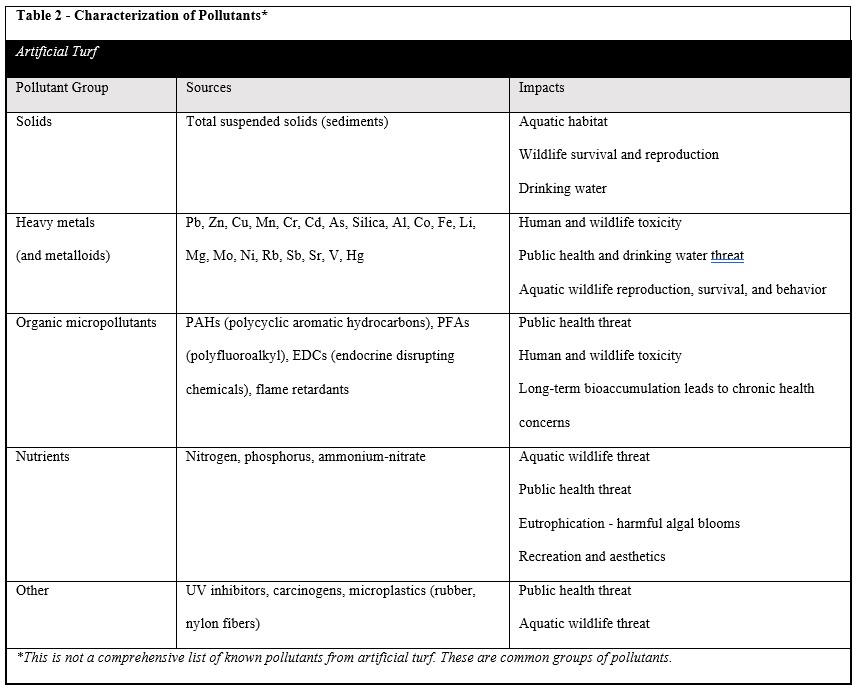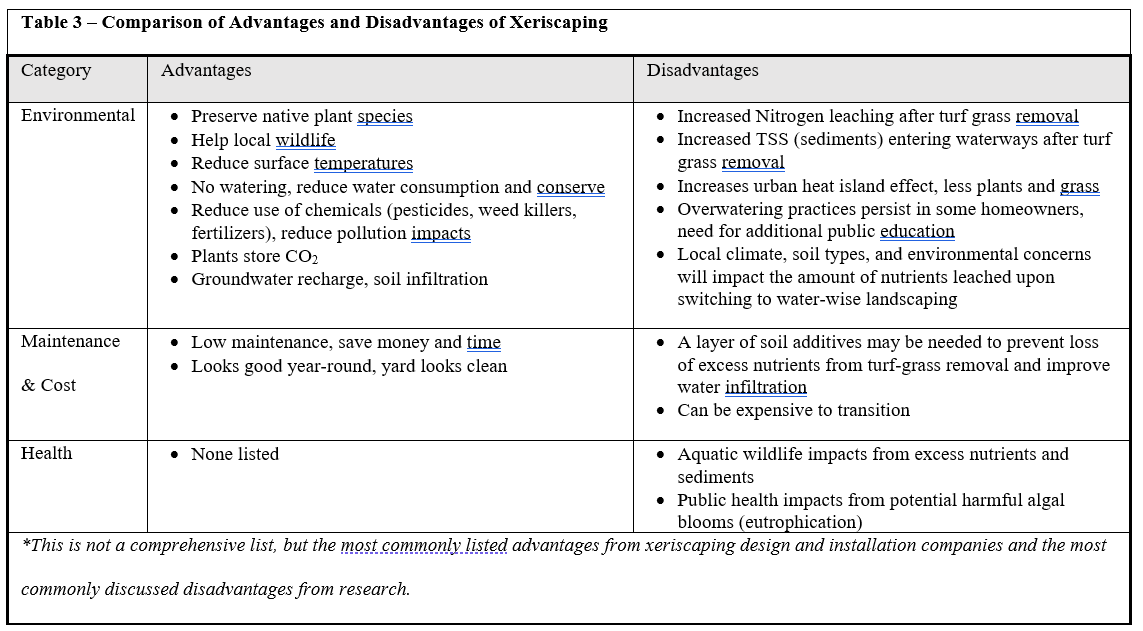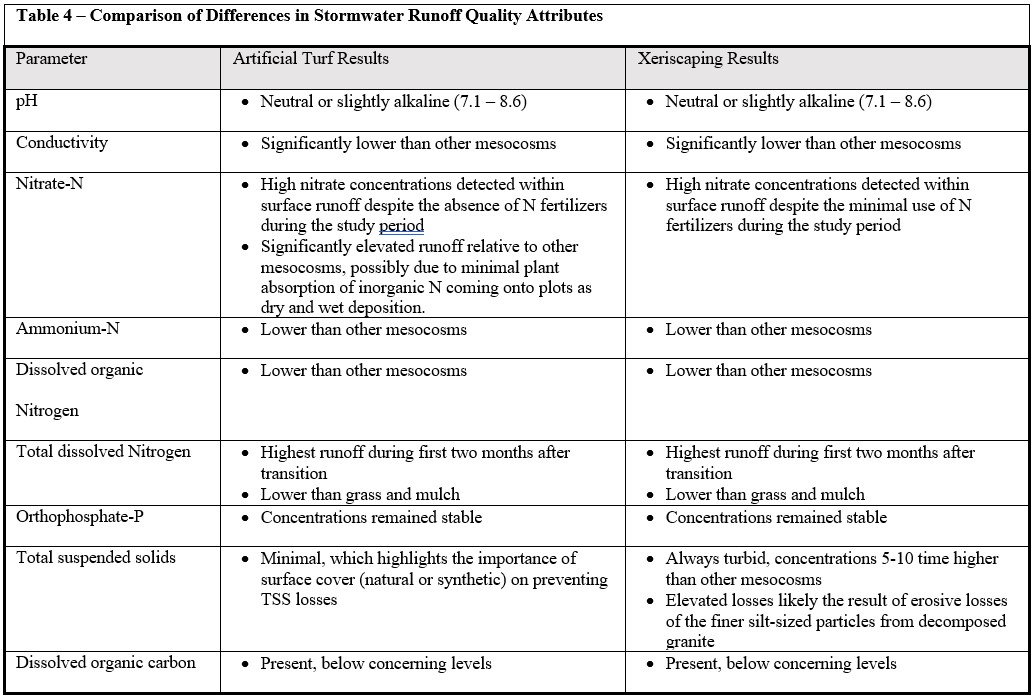Water Quality Impacts from Artificial Turf and Xeriscaping

As water scarcity increases throughout the Western United States due to climate change and population growth, states are increasingly concerned about having enough water to meet projected demand (Utah Division of Water Resources, 2021). Utah’s growth rates are expected to continue to exceed national rates over the next 50 years with population projected to nearly double by 2065 (Utah Division of Water Resources, 2021). More than 90 percent of Utah’s residents reside in an urban setting or an area transitioning to urban living (Utah Division of Water Resources, 2021). Steps are being taken to stretch Utah’s water supply, including higher density housing projects and landscape ordinances that require native plants and water-wise landscaping (Utah Division of Water Resources, 2021). In Utah, approximately 60 percent of residential water use is for irrigating landscapes (Utah Division of Water Resources, 2022). The prevalence of water-wise landscaping has been on the rise as homeowners are becoming more aware of how their watering practices impact water consumption in their communities (Endter-Wada et al., 2008; McCammon et al., 2009).
Two popular water-conserving landscape options are artificial turf and xeriscaping. There are plenty of resources on how to switch to artificial turf or xeriscaping, including best management practices for transitioning landscapes and planting, maintenance, and design guides; however, best management practices and guides for choosing a landscape with the lowest impact to water quality could not be found. This lack of resources indicates that the water quality of runoff from residential landscapes is often overlooked when considering water-conserving landscape solutions. While conserving water is highly important with continuing drought, climate change, and population growth, homeowners should also be aware that water leaving their properties carries pollutants to Utah’s waterways. The choice of plants and turf, hardscaping materials, soil, and chemical treatments impacts the water quality of landscape runoff. When planning a water-wise landscape, homeowners need to consider how to conserve water as well as how to minimize impacts to water quality.
This fact sheet presents the current understanding of water quality impacts from two water-wise landscaping options (artificial turf and xeriscaping). The end goal will be to use this research as a foundation to create resources for homeowners to better understand water quality impacts of different water-conserving landscape options and provide best management practices for transitioning yards with the lowest impacts to water quality.
There are many types of both xeriscaping designs and artificial turf grass options. The design and material options of both landscape types produce various amounts of water conservation and impacts to water quality.
Water Quality Impacts of Artificial Turf
Artificial turf grass is made of synthetic, man-made fibers that look like real grass. The synthetic grass blades are green and come in different pile heights. The turf is constructed in the same way that carpet is made with a solid backing in which the synthetic blades are machine stitched. Infill materials are used to help the synthetic blades stand, provide cushion, and tolerate consistent use. Under the artificial turf mat is a layer of fine aggregate stone followed by another layer of coarse stone filled with perforated pipes to help with water drainage. All of this is placed on top of compacted natural soil.
There are many advantages and disadvantages to using artificial turf as a water-conserving landscape option (Table 1). Companies that sell artificial turf frequently advertise its environmental-friendliness, low-maintenance cost and time, durability, and water conservation. While water conservation and the reduction of lawn-treating chemicals is a win for the environment, the literature shows that the adverse health and environmental impacts should not be overlooked. Additionally, the low maintenance cost is beneficial to homeowners in the long run, but the initial installation and landscape transition costs can be substantial depending on the type of artificial turf chosen and size of the lot being landscaped (Toxics Use Reduction Institute, 2016).

The impacts of artificial turf on water quality and the environment have been thoroughly studied and are well understood. The main concerns consist of environmental and health risks associated with the rubber materials used for the infill (Korbol, 2018). Several studies have shown that artificial turf infill contains hazardous organic chemicals, toxic metals, carcinogens, and microplastics (Bocca et al., 2008; Kruger et al., 2012; Cheng et al., 2014; Korbol, 2018; Zhang et al., 2021). Table 2 shows a list of the most common pollutants attributed to artificial turf. The largest factor affecting the types of pollutants coming from artificial turf fields is the type of infill materials used. Plastics and rubbers used for artificial turf and its components are usually equipped with stabilizing additives to help withstand environmental and human influences (e.g., sunlight, temperature changes, rainfall, playing, maintenance, cleaning, etc.) (Bertling et al., 2021). Environmental factors play a large role in the degradation of artificial turf. Heat and sunlight accelerate oxidative degradation by heating up the rubber infill, while freeze-thaw cycles can fracture the rubber accelerating weathering effects (Cheng et al., 2014). Abrasion from consistent use breaks down the plastics and rubber particles making it easier for them to be airborne or runoff during precipitation events (Cheng et al., 2014). Water causes leaching of soluble components, and wet climate conditions can lead to loss of the protective additives (Cheng et al., 2014).
Other studies have compared the advantages and disadvantages of different types of infill and found that there are alternatives which contain less hazardous substances, but these options are generally much more expensive and have yet to be significantly field tested and proven for performance (Cheng et al., 2014). Tire crumb rubber and sand infills have been tested and performance proven for decades (Cheng et al., 2014). Additionally, some alternative materials still release organic contaminants or have to be treated with chemicals for durability and safety making their environmental impacts similar to those of tire crumb rubber in the end (Cheng et al., 2014). One organic, plant-based option being tested is a coconut fiber and cork infill. Although it is a more environmentally friendly option, some users found issues with maintenance as the field grew weeds and mold and had problems with insects, thus needing to be treated with weed killers and pesticides (Massey et al., 2022).
Microplastics. The spread of microplastics into the environment is a growing concern. Research out of Sweden, Denmark, and the UK conservatively estimates hundreds of kilograms of microplastics entering waterways from each artificial turf athletic pitch every year, with some estimates reaching into the thousands (Li, 2019). In Norway, one researcher found microplastics in 85% of the soil samples collected from the bottom sediments of streams near artificial-grass pitches. Generally, microplastics were found closest to the turfs, but the study also found particles upstream and up to 4.3 km downstream. The study results determined rainfall is a driving force of microplastics leaving turf fields and ending up in waterways. During this transport process, only a fraction of microplastics is captured by the soil (Li, 2019). A Swedish study found that the location of a turf’s winter operations and the placement of snow during wintertime is crucial in terms of the amount of granulate particles that are released to adjacent waterways (Korbol, 2018). Another Swedish study (Regnell, 2019) showed that the bulk of potential microplastic dispersal from artificial turf can be prevented. The spread can be controlled by construction and maintenance precautions as well as by granulate traps in stormwater systems. Regnell (2019) found that microplastic spread prevention was most difficult directly after installation and decreased over time. Approximately 96 percent of the particle spread occurred during the first six months after the artificial turf was installed and only 4% spread during the second six months (Regnell, 2019). In all studies, wet weather conditions contributed to higher potential dispersal of microplastics to waterways from artificial turf pitches.
Water Quality Impacts of Xeriscaping
Xeriscaping is the practice of designing a landscape to limit the need for irrigation by replacing traditional water-consuming turf grass with drought-tolerant grass, native plants, and hardscaping (rocks, gravel, brick, pavers, etc.). There are many advantages and disadvantages to using xeriscaping as a water-conserving landscape option (Table 3). Companies that design and install xeriscaping frequently advertise its environmental-friendliness, low-maintenance cost and time, preservation of native plants, and water conservation. While water conservation and using native species is a win for the environment, the literature shows that increased sediment loading and nitrate leaching is common for many years after switching to xeriscaping (Heavenrich & Hall, 2016; Chang et al., 2022).

While the impacts of xeriscaping on water quality have been studied to a lesser extent, it is well understood that plants are beneficial for landscapes in many ways. Plants help store and cleanse water, maintain soil to prevent erosion and loose sediments from washing into waterways, uptake nutrients and CO2, and reduced the urban heat island effect (Heavenrich & Hall, 2016; Chow & Brazel, 2011). While the artificial turf is concerning for metals and chemicals, xeriscaping is problematic for total suspended solids (TSS) and nutrients, especially in the first six months to a year after removing natural turf grass and replacing it with xeriscaping (Chang et al., 2022). In two different studies, xeriscaping consistently produced high concentrations of TSS washing away with runoff (Heavenrich & Hall, 2016; Chang et al., 2022). This is due to the lack of plants and roots to hold down sediments. Additionally, the removal of turf grass opens more area to bare soil allowing erosion and sediment washing during precipitation events. When it comes to nutrients, xeriscaping has less plants to uptake excess nutrients. Newly planted species take years to mature to a stage capable of taking up more nitrogen. For nutrients, both studies found that removal of turf grass leaves large pools of nitrates, which leaches into waterways during precipitation events (Heavenrich & Hall, 2016; Chang et al., 2022). Heavenrich and Hall (2016) found that nitrate pools were four times larger in water-efficient landscapes compared to turfgrass lawns. Nitrate concentrations varied significantly with time since landscape conversion with the largest pools occurring nine to 13 years after turfgrass removal and declining to levels comparable to turfgrass after (Heavenrich & Hall, 2016). Declining nitrate levels could be attributed to increased nutrient uptake from mature plants, and/or nitrates leaching into deeper soil levels after many precipitation events.
Comparison Study
A 13-month study tested multiple types of water-conserving landscapes against a grass lawn to compare differences in stormwater runoff quality attributes. The study selected commonly chosen landscape options, including an established St. Augustine grass lawn and four alternatives, including xeriscaping, mulch, artificial turf, and sand-capped lawn (Chang et al., 2022). The researchers chose to monitor nine runoff quality parameters including pH, electrical conductivity, nitrate–N, ammonium-N, dissolved organic N, total dissolved N, orthophosphate-P, total suspended solids, and dissolved organic carbon (see Table 4 for results).
Findings from the Chang et al. (2022) study:
- Collectively demonstrate there is no one specific landscape best suited for mitigating runoff quality, but alternative landscapes should be selected based on local climate and environmental concerns.
- Demonstrate the importance of landscape composition on runoff dynamics and volumes.
- Traditional lawns and sand-capped lawns have better runoff control, especially during the growing season.
- Based on the results, rainfall captured by sand-capped lawns and mulch landscapes was almost two times as much as xeriscaping and artificial turf.
- Artificial turf and xeriscaping, landscapes based with materials containing finer particles, had higher potential of runoff.
- Runoff losses of TSS from lawns and artificial grass were low. This highlighted the importance of surface cover (natural or synthetic) on preventing TSS losses.
- An additional layer of compacted decomposed granite used for xeriscapes and artificial turf helped protect legacy soil phosphorus from leaving with runoff.
- Construction, base materials used, and/or plant species composition creates differences in runoff quality parameters.
- Results of this research are likely most relevant to warm-temperate climates, so additional studies are needed in areas undergoing annual freeze–thaw cycles.

Conclusion
Conserving water is highly important in Utah with continuing drought, climate change, and population growth. Concerned homeowners may choose to transition their yard to a water-wise landscape to reduce their water consumption. When planning a water-wise landscape, homeowners need to consider how to conserve water as well as how to minimize impacts to water quality. The choice of plants and turf, hardscaping materials, soil, and chemical treatments impacts the water quality of landscape runoff. Artificial turf and xeriscaping, two popular water-conserving landscape options, show promising results for conserving water use; however, both options have a higher potential for runoff and lower potential for rainfall capture and infiltration. Additionally, each option increases pollutants ending up in Utah’s waterways. Artificial turf is known to contribute large amounts of microplastics to waterways, while also leaching harmful chemicals, metals, and organic micropollutants. Xeriscaping significantly increases sediment loads in runoff and leaches high amounts of nitrates into stormwater. There are many types of xeriscaping and artificial turf grass options. The design and material options of both landscape types produce various amounts of water conservation and impacts to water quality. It is important to weigh the advantages and disadvantages of each landscape option for both water conservation and water quality before switching.
References
Bertling, J., Dresen, B., Bertling, R., Aryan, V., and Weber, T. 2021. Artificial turf pitches – System analysis for Switzerland and Germany taking into account micro-plastic and greenhouse gas emissions, recycling, locations and standards, costs, and player opinions. Oberhausen, Fraunhofer UMSICHT. https://doi.org/10.24406/umsicht-n-640929
Bocca, B., Forte, G. Petrucci, F., Costantini, S. and Izzo, P. 2008. Metals contained and leached from rubber granulates used in synthetic turf areas. Science of the Total Environment, 407, 2183-2190. http://dx.doi.org/10.1016/j.scitotenv.2008.12.026
Chang, B., Wherley, B., Aitkenhead-Peterson, J.A., and McInnes, K.J. 2021. Effects of urban residential landscape composition on surface runoff generation. Science of the Total Environment, 783. https://doi.org/10.1016/j.scitotenv.2021.146977
Chang, B., Wherley, B., Aitkenhead-Peterson, J. et al. 2022. Short-term impacts of urban landscape conversion on surface runoff quality. Urban Ecosystem, 25, 1561–1576. https://doi.org/10.1007/s11252-022-01247-2
Cheng, H., Hu, Y., and Reinhard, M. 2014. Environmental and Health Impacts of Artificial Turf: A Review. Environmental Science & Technology, 48, 2114-2129. dx.doi.org/10.1021/es4044193
Chow, W.T.L. and Brazel, A.J. 2011. Assessing xeriscaping as a sustainable heat island mitigation approach for a desert city. Building and Environment, 47, 170-181. https://doi-org.dist.lib.usu.edu/10.1016/j.buildenv.2011.07.027
Endter-Wada, J., Kurtzman, J. Keenan, S. P., Kjelgren, R. K., and Neale, C.M.U. 2008. Situational Waste in Landscape Watering: Residential and Business Water Use in an Urban Utah Community. Journal of the American Water Resources Association. https://doi-org.dist.lib.usu.edu/10.1111/j.1752-1688.2008.00190.x
Heavenrich, H. and Hall, S. J. 2016. Elevated soil nitrogen pools after conversion of turfgrass to water-efficient residential landscapes. Environmental Research Letters, 11. http://dx.doi.org/10.1088/1748-9326/11/8/084007
Korbol, O. (2018). Microplastics in freshwater sediments: An investigation of stream sediments downstream of artificial football turfs. [Master’s thesis, Norwegian University of Life Sciences].
Kruger, O., Kalbe, U., Berger, W., Nordhaub, K., Christoph, G., and Walzel, H.P. 2012. Comparison of Batch and Column Tests for the Elution of Artificial Turf System Components. Environmental Science & Technology, 46, 13085-13092. http://dx.doi.org/10.1021/es301227y
Li, R. (2019). Tracking Microplastics from Artificial Football Fields to Stormwater Systems. [Master’s thesis, Stockholm University]. Diva Portal.
Massey, R., Pollard, L., Tian, Z., and Evans, S. (2022, January 27). Environmental Health Impacts of Synthetic Turf and Safer Alternatives [Webinar]. CHE Partnership. https://www.healthandenvironment.org/webinars/96595
McCammon, T. A., Marquart-Pyatt, S. T., and Kopp, K. L. 2009. Water-Conserving Landscapes: An Evaluation of Homeowner Preference. Journal of Extension, 47(2). https://digitalcommons.usu.edu/cwel_pubs/60
Regnell, F. (2019, October 24). Dispersal of microplastic from a modern artificial turf pitch with preventive measures - Case study. Ecoloop. https://www.genan.eu/wp-content/uploads/2020/02/MP-dispersal-from-Bergavik-IP-Kalmar-Report.pdf
Sagers, L. A. 2005. Xeriscaping Series # 12 - Gardening in a Water Challenged Environment. All Archived Publications. Paper 1545. http://digitalcommons.usu.edu/extension_histall/1545
Toxics Use Reduction Institute. (2016, September). Sports Turf Alternatives Assessment: Preliminary Results Cost Analysis. UMass Lowell. https://www.turi.org/content/download/10395/173557/file/Cost%20Artificial%20Turf.%20September%202016.pdf
Utah Division of Water Resources. (2021, January). Chapter 2 Population & Municipal Water Use. Retrieved December 14, 2022, from https://water.utah.gov/wp-content/uploads/2022/01/2021-Water-Resources-Plan-Chapter-2.pdf
Utah Division of Water Resources. (n.d.). Weekly Lawn Watering Guide. Retrieved December 14, 2022, from https://conservewater.utah.gov/weekly-lawn-watering-guide/
Zhang, X., Wang, Y., Liu, J., Jiang, Y., Tian, Y. and Zhang, Z. 2021. Distribution and Health Risk Assessment of Some Trace Elements in Runoff from Different Types of Athletic Fields. Journal of Chemistry, 2021. https://doi.org/10.1155/2021/5587057
Authors
Lauren Houskeeper, Water Quality Programs Assistant
Erin Rivers, Water Quality Extension Specialist

